In an SHTF situation, no one knows what to expect. Yet, we have to be well prepared.
One of the main things we need to have secured is food, but stockpiling and prepping foods can add up to be a little bit expensive.
That’s where having sustainable food sources comes in. I always recommend growing/ raising your own food.
Having livestock, even a small one, can be a very smart decision and should be on any prepper’s survival plan. It is something that you can benefit from almost immediately, while also lasting you during difficult times.
Livestock can be useful in more than one way. We can mention producing foods and raw materials, a cash investment, transportation, and many more, depending on your need and the animal you chose to raise.
Related: Livestock Animals You Should Start Raising For The Upcoming Economic Crisis
I recently started reading articles online and making research on the right animals to raise and have in times of crisis, in order to educate myself.
I found many options, such as ducks, rabbits, goats, and many more, but the most common and easiest one is chickens.
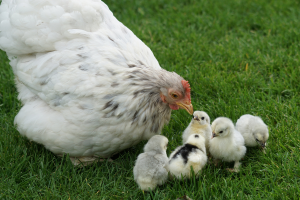 Chickens are family-friendly and can be raised in small spaces and backyards, whether it’s an urban setting or a rural one.
Chickens are family-friendly and can be raised in small spaces and backyards, whether it’s an urban setting or a rural one.
These birds are very low maintenance and also a good source of protein, providing up to 300 eggs per year, as well as quality meat.
Their manure is also considered one of the best types of organic fertilizers to use.
All of that makes them the most common and widely raised animals.
Here are some of the most frequent mistakes people make when raising chickens and ways to avoid them.
Having A Chicken Coop That Is Too Small
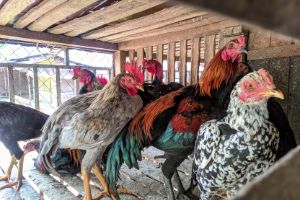 I know I have mentioned that chickens can be raised in small spaces, but not too small.
I know I have mentioned that chickens can be raised in small spaces, but not too small.
Your flock needs to have enough room to live comfortably without starting squabbles. I would also recommend building/having a chicken coop that is bigger than what you think you need.
The coop should be able to hold a feeder and water containers, a roosting area (very preferable), and a square nest box for every three hens.
⇒ 50+ Chicken Coop Secrets For A Low Effort Protein Source
A proper coop should also be roomy enough to be able to stand in it to collect your eggs and shovel manure comfortably.
Not Protecting Them From Predators
Now that you chose the right coop size, let’s discuss your flock’s safety. Chickens have different predator species, dogs, snakes, raccoons, cats, skunks, hawks, and the list goes on.
Meaning they are not safe no matter where you live. Backyard’s flocks are even more susceptible to being attacked than farmer’s ones.
So how do you protect them? Here are some useful tips :
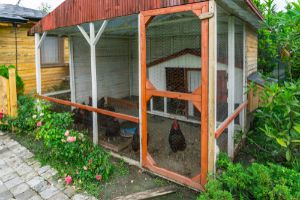 Build a high quality, tall fence around your property
Build a high quality, tall fence around your property- Always lock your chickens in at dusk, making sure windows and doors are shut tight. You can use spring-loaded latches to make them harder to open.
- As for outside guardians, guard dogs are a great choice.
- Make sure your chicken coop is close enough to your house, as having human activity tends to keep most animals or predators away.
- Reinforce the bottom of your coop. Add a hardware cloth skirt around the outside to prevent anything from burrowing underneath it.
- Remove all food remaining—garbage, livestock feed, fallen fruits from trees, or anything that can serve as an attractant to other animals.
- Consider raising a rooster, as it doesn’t only serve to fertilize your eggs and expand your flock but is also a protector of the hens against any predators.
Not Counting Your Chicken Flock
You have to keep count of your flock, or else, how would you notice if you have attracted any predators? Make sure you count them every night before locking them in their coop.
Missing a chicken can be alarming and often requires immediate action to save the rest of the flock. So, keeping track of your chickens is an essential act.
Keeping Your Vegetables Unsupervised When Your Chickens Are Out
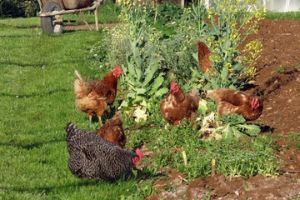 Chickens are active creatures. They enjoy exploring and playing around. By doing that, they till the earth with their feet and beaks and naturally fertilize your garden.
Chickens are active creatures. They enjoy exploring and playing around. By doing that, they till the earth with their feet and beaks and naturally fertilize your garden.
They also feed on insects, and mosquitos as well as some weeds, helping around your garden/backyard.
As beneficial as they are, they can also be as destructive to your vegetables and medicinal plants, by digging holes in your garden where they shouldn’t or eating your green leaves.
⇒ A Kit That Has Everything You Need To Start Your Medicinal Herb Garden
To prevent that from happening, installing a fence around your veggies is the best thing you can do.
Overspending On Chicken Food
Now of course you can choose to spoil your chickens by getting them store-bought feed, which costs around about $20 per 50-pound bag. Prices may vary depending on your location and the quality of the product.
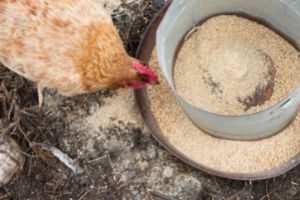
In case you didn’t know, chickens love vegetables, grains, and fruits. And it’s mainly what they consume and what the store brought feed is made from.
What you can do instead is, give them table scraps/veggies peels or even plant herbs for them. It will save you a lot long term as well as limit your food waste.
Feeding Them The Wrong Foods
I mentioned how low maintenance chickens can be, even regarding their foods, as most vegetables and fruits are safe for them to feed off. Yet, there are things you cannot feed them.
These include sugary things, food high in salt and fat such as avocadoes, raw potatoes or their peels, uncooked beans, anything that is spoiled, citrus fruits and citrus peels, and anything fried or processed.
The rule of thumb is anything organic you can eat, they most likely can too.
Not Exposing Them To Enough Light
Daylight is very important for the chicken’s reproductive system. Of course, they still need darkness to be able to sleep and recharge, but other than that, they are to be in the light.
So make sure they are exposed to daylight, natural or artificial, at least 14 hours a day. That way, you will have happy chickens and keep getting your daily delicious eggs.
I tried to provide the most important information about chickens’ livestock. There’s of course always more to learn, but this should be enough to get you to start.
In times of crisis, you are going to be glad you started acquiring survival livestock this soon. It will prepare you to better take care of your animals, provide them with an optimal environment, as well as learn to harvest and preserve the meats or maybe even start breeding to add more chickens to your flock.
All this while benefiting from the goods your birds provide for you almost daily, such as eggs, feathers, and natural fertilizers.

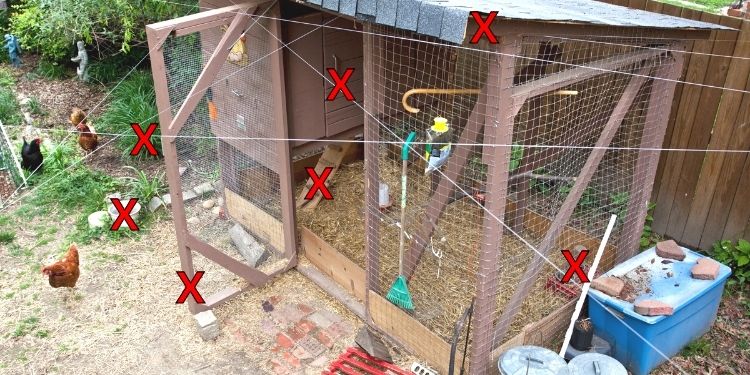













If a predator comes and kills your chicken or chickens.
Dont bury it. Save the bird.
Take the bird and put it where you can watch it.
In three days, that predator will come back. Then kill that predator. Two legged or four… Remember the four legged ones are the smart one’s. So true…
A raccoon will kill all, then come as they please to eat at there will.
A skunk will kill and then eat guts and head, but leave the body.
A possom will kill and eat and leave what they do not eat.
Chickens will eat each other, also.
This info is from life experiences in my area and my life. Your area might be different.
Plus add oyster shell to there diet. Get harder egg shells.
Show them love and the will return the favor.
Ameraucana chickens, have the best eggs,. lower in cholestral, also. plus the colors are pretty cool to see. blue green in color. This is called (Wheaten).
Good stuff!
red ant: Americana love snow. those are the only birds I ever saw who would scratch thru snow to forage. niio
red
Ya those are the hardest chickens that I had.
Lost them by a ratcoon. It happens. Need to get me some more. There eggs are the best.
red ant: I never saw such friendly roosters, either. But, when stray dogs came after the hens, the rooster stent them away screaming in pain. Same with a boar bear. But, he would take food out of the hands of little kids. I used to trade extra roosters to a Chinese restaurant for free food right now, we’re thinking of getting partridge rock. Rocks are friendly but tough, and can take our heat. If not them, then Mexican native hens (quail rump chickens). they don’t lay well (150-200 eggs a year), but are survivalists. People cage them till noon, then let them out to forage. niio
right now, we’re thinking of getting partridge rock. Rocks are friendly but tough, and can take our heat. If not them, then Mexican native hens (quail rump chickens). they don’t lay well (150-200 eggs a year), but are survivalists. People cage them till noon, then let them out to forage. niio
Last coon that killed our chickens I live trapped. Shot him in the head and took his head off and put it on a spike.
Coons are assholes and I will always shoot them along with skunks and weasels.
If you do pee near the coop it can help deture the predators as well.
Guard geese seem to help in the coop as well
raven: coons are gross and violent. Like cats, they kill for fun. Also, mind because they can carry rabies, as can skunks.
I concur on Auracanas. They also come in every coloration and configuration known to chickendom. They can range from glistening white with ruffs to iridescent black looking like “ordinary” chickens. You can have a flock of more than 20, and no two will look the same. It makes it easy to keep track, but I wish you luck in determining who is laying what. Every color from pale yellow through the pinks and blues to avocado green. They are truly “Easter-egg” chickens. We had one (Eagle Head) that looked like a bald eagle. Lovely turquoise eggs.
Has any one ever ate the black skin chickens. Seen it and the funny lookin fuzzy chicken, but never ate one.
Dose it taste like chicken. lol…
Don’t know if I would want any of them. They seem to get really nasty around there feet and lower area.
My all time favorite is the Giant Light Bramas. good crackle berries and good meat bird.
They make soup in Asia with the black skinned chickens. It’s safe to eat and tastes like regular chicken.
Thank you. Was just wondering. Is the meat black, as well?
Maybe will get to try one, one day… Seems odd, being black.
Outer meat is blackish stained, but the inner meat is white.
# 8 Depend on law enforcement to protect your kids in an “active shooter” incident at their school.
not funny
Cops are a joke so it’s funny
Chickens need protein and calcium, too. Feeding them their egg shells when you’re done with the eggs can take care of the calcium. Oyster shell can supplement. How much protein they will get from foraging insects will depend on the location. Desert areas don’t have nearly the bug population that humid/wet areas do. (chicken food is up to $25 for 50#, and that is not the organic stuff, which costs more) There are cheaper options for food, but I found it either turned to powder easily or my chickens didn’t eat it. I am allowed 6 hens (per city code). Also, chickens CAN eat potatoes and peels, just not raw, green ones. They are good at using up leftovers, not much makes it into my compost bin these days. One thing to consider is whether you will cull a hen once they quit laying. I had a hen that lived to be over 10 years old. She hadn’t laid an egg in at least 4 years. Not much good for food when they get old, other than soup. In a SHTF situation, I probably wouldn’t have a problem sending the older girls to freezer camp, but in the meantime they are pets with benefits.
Black soldier fly larvae can eat the undersirable food compost that you don’t want to feed your chickens (including rotting food) – they’re high in protein and chickens love them!
Corn beetle larvae, called mealworms, are good for your chickens too. Every Spring, I lay out several layers of egg cartons and sprinkle cracked corn in each layer. Once the larvae hatch, I simply put them in the solar food dryer. My chickens consider them quite a treat.
If you find a nest of “pinkies” (baby mice) feed those to your chickens too! They will actually quarrel over a single pinkie.
You can also through some lime on it and it will decompose starting around 3 days and won’t last long.
My 6 hens get very excited when I get ready to mow the lawn. As I go by their coop, I make sure that the cut grass heads their direction.
4 are Golden Comets, two of them produce extra-large to jumbo eggs while the other two produce what stores would grade as large eggs. The other two are Ameraucanas. Both lay smaller medium eggs. Matilda, the white one, consistently lays blue-green eggs and Goldie lays brown.
They are definitely entertaining and it is fun to pick a fig from the tree when they are watching. I have to share, or they do get upset.
Great info , Great web site with all the in put.
Larry Allen Ellsworth
Kendall ,Wis
I love all the info I get from this site!
My computer would not open the link to 295 lbs of food for $5 a week. Got a message there was not a secure connection.
chickens also love bugs, and if you don’t think so watch how much less mosquito’s, caterpillars flys and etc you have around. In fact one day I watched as they picked flys off a dog bone in the yard. They are omnivorous.
When feeding your chickens their egg shells. Make sure that you cook them in low oven about 225 for about an hour. They get nice and crumbly for them. Plus, you do not want them to get a taste for fresh eggshells or they will start to eat the shells of your eggs.
Chickens also love snakes!@
I love them for this!! I am terrified of snakes.
When the grandboys find a snake they bring it to scare grandma!! I scream and try to run away. Yelling give it to the chickens!! They think it’s hilarious. But my chick’s Love !them!! They chase it down and kill it then run about trying to keep it from the other girls. Gone!! Even a dead one that got hit by weed whacked they love.
Long live the snake killing chickens!!!
Peace
MadFab
MadFab
Good to hear from you.
If you don’t like snakes, then you need to watch out for snakes staying under the chicken. Would slid my hand under them to get the eggs. There would be a big O chicken snake, Instant chills. Then the death wip, slap the wall…
‘Still would not trade it for city life. lol…
Red Ant,
Thank you. I am always lurking, but don’t comment too much.
I would absolutely ha e a heart attack and die if I ever grabbed a snake under my chicken!! I will probably have to have my grandboys gather the eggs for a few days now.
I thought you were my friend? LOL ?
Hope you and yours are doing well. Enjoy the weekend.
Peace
MadFab
PS,
Speaking of Lurking, where is LCC, Armin, and Miss Kitty.?
Hope all is well.
Here in SE California there’s a friendly king snake in one of my chicken pens during the day, about twice a week. It’s going down mouse holes. Mice come out at night to eat the feed the chickens waste on the ground. King snakes will also kill and eat dangerous rattlesnakes. So we don’t harm the kings. They are black with yellow stripes, small oval heads and pointed tails.
Nice to hear from you MadFab. Any news from OH recently?
Was sad to see Beachen getting hammered over at our old site.
Seems shortages are all around yet so far folks haven’t done the COVID TP drill YET.
Chickens are lovable carnivores. Maybe omnivores is better
PVC arches with chicken wire keeps flying predators honest. Beware Ravens and Crows do enjoy chicks. Painting the PVC keeps sunlight damage down for years of service. Obviously tree limbs and other field expedient options exist.
Could you please pass on to our rained out friends over at MSB that hügelkultur and variants of that have excellent drainage for plating in wet areas like the Olympic Peninsula.
Killhouse rule #5 always be working, theres always something you can do to improve your situation.
Michael,
Good to see you also. OH is still kicking about. Sends lots of videos about shortages and the like. Haven’t talked to him personally for about a month.
Will let Olympic Penninsuka dweller know about hugelkulture.
Putting in some gravel and drainage ditches about her place. Standing water everywhere.
Today is the 2nd day in a row we haven’t had any rain. Apr, May and most of June rain every day. We sure could have spared some to All the folks in drought and taken some of their sun. None of the farmers in my small area have been able to even get tractors in the field, much less get a corn crop in. Neighbor at the bottom of my hill still has ponds bug enough for ducks and geese to be swimming in. Might be able to get 1 cutting of hay this year. Usually he gets 3 and 1 of his fields of corn. Scary times.
Yes sorry Beachin decided to leave. I think her Hubby is a doc, so she voted all worked up. But, when ya start calling folks idiots and F heads, then that’s too much. I have a mantra from my OR days that I use daily. I only have to be here for 12 hours and then I get to go home to my loved ones. I can do almost anything for 12 hours, then I can do me. Works for me, but folks are really getting Tense these days. Everyone is nervous scared or whatever. I see and feel it everywhere I go. Tonight I ran to the store for a quick few things, like 7 pm. Squabble started in the produce area and escalates to yelling and following customer about the store. I put my basket down and left. Had two of my grandboys with me. Not taking any. Chances with their or my safety.
Hope all is well with you and yours. Going to the lake tomorrow for some fun and no electronics except for 1 emergency phone.
Can’t wait.
Peace my friend
MadFab
Back when I had a hobby farm in VA, we used the same netting used for quail over our chicken yard. We just stretched it out and nailed it to the posts. We never lost a single chicken or chick to a raptor. We used hardware cloth around the bottom foot of the pen (buried six inches into the ground), chicken wire for the next three feet up, and did the rest in plastic chicken netting. Our penned area had eight foot walls all around. We only lost birds when we let them out to play in the woods…
We had hawks eyeballing our flock when we were kids.
The neighbor’s dog ultimately got the Silkies.
We had one huge, aggressive rooster, whose breed I forget,
he was king of our hill.
Bantams, we free-ranged.
They went into the tree branches at night, making them pretty easy to collect for the winter.
Weasels were our winter problem.
Yeah, we had the hatchet and big stump out back.
I never figured out the chicken plucking though.
Shoot the hawks
raven we never had a hawk problem, but always had roosters. It was the hawks that had a problem. You must not know a lot about living free.
Have roosters and the do a decent job at watching for hawks. However hawks coons and other creatures must die if they come after my birds
raven. Then, yes.
shoot the Ravens
dz Shoot the raven…Yes, I see your point but once SFTF is underway, I’m sure someone will.
Yo, live birth (of vipers) starts in a few weeks. If you need to know where they hang out, watch for ravens. They eat most new rattlers and so on. niio
There’s definitely a balance to be struck between the benefits of adding livestock and being able to feed said livestock. We live in the desert, so as Valerama noted, there’s not a lot of protein forage for our chickens. Plenty of predators. We’ve been researching what we’d feed them if/when SHTF. Kitchen scraps, yes. Do we need to think with planting crops for feed? Anyone here doing so?
I’ve been reading of other owners who use a set of 7trays to grow sprouts for their chickens to eat. Just add seeds and water to tray, watch them sprout and feed to chickens. You can look up videos of how to be successful online. Also, nobody said this but chickens love meat and it is nutritious for them. When you are done with any meat on a bone, let them finish picking it clean. They LOVE it!
vanlightner: Very good advise. Sprouts will not cause overheating like grain will. niio
Thanks, vanlightner, good idea. I do sprout seeds for them now and it’d be easier to have in storage than regular feed. And the meat bones–yes!
Rookie: We’re 45 miles north of Tucson. Can you access black soldier flies? Eggs are usually sold. They eat about anything and poultry love them. A heavy layer of mulch in a run, keep it moist, will add to their feed and add a lot of vitamins to the diet. Ground mesquite, mesquite leaves (which have the same feed value as clover), crickets, flies and fleas. Winter is clover, turnip greens, beet greens, and fallen fruit. If in Arizona, look for Edge of Nowhere Farms on you tube. They started a new orchard but have layers and so on. For me, turkey would be the best. Gobblers are nuts about defending hens. the desert is rich in feed. Bugs, seeds, and greens. niio
Red, we’re north of Reno, NV, so kinda sorta the same. On the black soldier flies, we use the dried larvae currently as protein supplement/treats, but have not looked for eggs. And I must admit I’m scratching my head at the thought of purposely adding flies. : ) So I’m guessing the eggs hatch flies, which lay more eggs and the cycle just continues? Very interesting about mesquite leaves having the same feed value as clover! Thanks for that, will have to see if I can get mesquite to grow here. All good stuff in your reply–thanks much!
Rookie: Black soldier flies don’t have mouth parts. They breed, lay eggs, and die. Grubs eat about anything set before them, like fly eggs and maggots, gnats and their eggs. If you have grubs, when butchering, bury the offal in the compost. They’ll eat it fast and go looking for more. when a younger sister froze sweet corn, all shucks and cobs went in the compost. A week later, nothing was left but black soil. They don’t eat bones, but will polish them fast. No fuss, no muss and definitely no gnats. niio
Rookie:
When we rake out the chicken pens and spread it on the vegetable garden beds, the wild bird and sunflower seeds the chickens spilled sprout. Then we take the mature seed heads back to the chickens to eat. I also spread the pen litter in the hens’ foraging area to grow into seed bearing plants there.
That’s impressive, Red. I’m on it!
I keep my Staffie in the yard at night. Never have problems and this coon country. She loves those birds.
We’ve raised Australorps for years in high desert heat in summer snow in winter. Very hardy, lay large brown eggs and are pretty docile. They’re jet black with an irridescent sheen. Not very broody, tho.
Lynn: I like them but like partridge rocks better. Not a lot of eggs, but they go broody and are somewhat self-sufficient. Best meat birds are bantams. Not a lot on a carcass, but the hens love to set if you steal the chicks early. They’re better in the heat than most, but chickens should thrive in the heat. they came from the tropics. niio
was thinking about starting a small chicken flock, maybe 10 12 birds, but don’t really know what breeds to get? just looking for a good layer that would also be a decent for meat. I don’t know if about 180 to 220 eggs a year would be a lot to expect. also good at finding their own food and broody.
I love Americaunas. They’re friendly and good layers. They also have blue green eggs, which weirds people out; some people refuse to eat them. My best broody hens were Buff Orpingtons. They’re calm and will brood anyone’s eggs. They’re great to have in the flock if you have a breed you love that won’t brood well. Just pop the eggs into a buff’s nest and it’s a done deal.
And watch out for companies like Tractor Supply who make chicken feed that prevents chickens from laying eggs.
I buy my organic chicken feed from tractor supply. There was some issue in the spring with Purina chicken feed preventing egg production but Mike Adams, the health ranger did an expansive series on ingredients that Purina used but found no proof that Purina feed was hindering egg production. I don’t use Purina only organic for my free range birds.
We buy our chicken food locally from a guy that makes it himself. have had great results in upper central NY. price is also a bit cheaper.
for sure coon are the worst – have put away too many coon, possum and skunk to count, that’s a lot of ammo which is too expensive to waste on those critters so now i drown them, i don’t like it but….
we have hawks too – i put chicken wire over the top of the run, once they bounced off the top that ended that, still can be an issue when i let the girls out but the smart ones hang out under cover when they know they’re being stalked.
for snakes – get bird netting, put it anywhere there’s an opening, snakes get stuck in it and that ends that. i was so furious with one that had swallowed a pullet that i cut it open, of course i knew the pullet was gone but i wasn’t letting it go to snake hell with a full belly
AR15 – check murray mcmurray you can look at their website and/or ask for a catalog, you can check each breed for all of the characteristics you’re looking for.